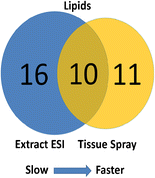A Comparison of Tissue Spray and Lipid Extract Direct Injection Electrospray Ionization Mass Spectrometry for the Differentiation of Eutopic and Ectopic Endometrial Tissues |
| |
| Authors: | Vitaliy Chagovets Zhihao Wang Alexey Kononikhin Natalia Starodubtseva Anna Borisova Dinara Salimova Igor Popov Andrey Kozachenko Konstantin Chingin Huanwen Chen Vladimir Frankevich Leila Adamyan Gennady Sukhikh |
| |
| Affiliation: | 1.V. I. Kulakov Research Center for Obstetrics, Gynecology, and Perinatology, Ministry of Healthcare of the Russian Federation,Moscow,Russia;2.Jiangxi Key Laboratory for Mass Spectrometry and Instrumentation,East China University of Technology,Nanchang,China;3.Moscow Institute of Physics and Technology,Dolgoprudnyi,Russia |
| |
| Abstract: | Recent research revealed that tissue spray mass spectrometry enables rapid molecular profiling of biological tissues, which is of great importance for the search of disease biomarkers as well as for online surgery control. However, the payback for the high speed of analysis in tissue spray analysis is the generally lower chemical sensitivity compared with the traditional approach based on the offline chemical extraction and electrospray ionization mass spectrometry detection. In this study, high resolution mass spectrometry analysis of endometrium tissues of different localizations obtained using direct tissue spray mass spectrometry in positive ion mode is compared with the results of electrospray ionization analysis of lipid extracts. Identified features in both cases belong to three lipid classes: phosphatidylcholines, phosphoethanolamines, and sphingomyelins. Lipids coverage is validated by hydrophilic interaction liquid chromatography with mass spectrometry of lipid extracts. Multivariate analysis of data from both methods reveals satisfactory differentiation of eutopic and ectopic endometrium tissues. Overall, our results indicate that the chemical information provided by tissue spray ionization is sufficient to allow differentiation of endometrial tissues by localization with similar reliability but higher speed than in the traditional approach relying on offline extraction. |
| |
| Keywords: | |
| 本文献已被 SpringerLink 等数据库收录! |
|

